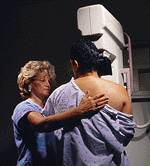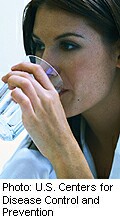| 
Young Women's Breast Tissue Offers Clues to Cancer Risk
 WEDNESDAY, April 29 (HealthDay News) -- Breast cancer risk assessment and prevention should start much earlier in life than it currently does, say Canadian researchers who examined breast cancer risk factors in young women.
The study of 400 women, ages 15 to 39, and their mothers found that breast tissue composition in young women may be associated with their risk for breast cancer in middle age and older.
"It is known that the breast is most susceptible to the effects of carcinogens at early ages. Our findings suggest that differences in breast tissue composition in early life may be a potential mechanism for this increased susceptibility," wrote a team led by D. Norman Boyd, of the Campbell Family Institute for Breast Cancer Research, Toronto. By identifying the environmental and genetic factors that influence breast tissue composition early in life, we may be able to develop safe and effective methods of prevention."
In this study, the researchers looked at the amount of dense breast tissue (mammographic density, or MD), which varies considerably among women and is a significant risk factor for breast cancer in middle-aged and older women.
Experts know that the risk of breast cancer increases as MD increases. However, little has been known about the development of MD early in life or how the MD of young women is related to their height, weight, age, and their mother's MD.
The study authors concluded that a "high degree of mammographic density in middle age, when it is a strong risk factor for breast cancer, may arise from the subset of the population with the greatest amount of fibro-glandular tissue in early life, when susceptibility to potential carcinogens is greatest. Interventions directed at the prevention of breast cancer may therefore be more effective if they are started in early life rather than adult life."
The study appears online and in the June print issue of the The Lancet Oncology.
More information
The U.S. National Cancer Institute has more about breast cancer risk.
|  |

Acrylamide Doesn't Raise Lung Cancer Risk
 TUESDAY, April 28 (HealthDay News) -- Acrylamide, a food byproduct that some research has linked to certain cancers, doesn't raise the risk of lung cancer in men and may even offer slight protection for women, new research suggests.
In a study that included more than 120,000 men and women, Dutch researchers reported that they found no association between lung cancer and acrylamide in men and an 18 percent lower risk in women for a 10-microgram/day average intake of acrylamide.
"After taking smoking and other lung cancer risk factors into account, it turned out that men who ingested more acrylamide were not more likely to be diagnosed with lung cancer than men who consumed less acrylamide," said study author Janneke G.F. Hogervorst, of Maastricht University in the Netherlands.
"Unexpectedly, women who ingested more acrylamide were less likely to be diagnosed with lung cancer than women who ingested less acrylamide," said Hogervorst, who added that since this is the first study to come to this conclusion, the findings need to be replicated before any dietary recommendations could be made.
The findings appear in the April 28 online issue of the Journal of the National Cancer Institute.
Acrylamide is a chemical that forms during some high-temperature cooking processes, such as roasting, baking or frying. The compound was first discovered in food in 2002, according to the U.S. Food and Drug Administration. Some common foods that contain acrylamide include potato chips, French fries, baked goods, coffee, bread and cookies, according to the study.
Approximately one-third of the calories Americans consume contain acrylamide, according to an accompanying editorial in the same issue of the journal.
Animals exposed to high doses of acrylamide have developed cancer, and although many studies have now been done on humans, the results have been mixed. Karen Collins, a nutrition adviser for the American Institute for Cancer Research, said some studies have found a positive association between acrylamide and renal, ovarian and endometrial cancers, but that the evidence isn't conclusive yet. Other studies have found no association between acrylamide and gastrointestinal, colorectal, bladder, breast and prostate cancers, according to the editorial.
The current study included 58,279 men and 62,573 women, with an average follow-up time of 13.3 years. From this group, 2,649 people developed lung cancer.
When the researchers compared those with the highest intake of acrylamide to the lowest, they found no association between male acrylamide consumption and lung cancer. In women, those who had the highest intake appeared to have a 55 percent decreased risk of cancer compared to women who had the lowest acrylamide intake, the researchers said.
The authors theorized that acrylamide may have some effect on female hormones, which could offer protection against certain cancers, and increase the risk of others. "We do not advise women to start consuming more acrylamide-containing foods to reduce their lung cancer risk," noted Hogervorst. "Acrylamide may increase the risk of other cancers, and acrylamide-containing foods like fries and chips may increase the risk of other diseases, such as obesity and cardiovascular diseases."
"Acrylamide is such a complicated dietary factor," said editorial author Lorelei Mucci, an assistant professor of medicine in the department of epidemiology at the Harvard School of Public Health. "It's in so many foods that are really bad for you, but a large portion of acrylamide comes from whole grain cereals and breads that are good for you."
"The public health message should really be to look at factors that really will lower your risk of cancer: exercise, keeping a healthy weight and not smoking. If there is an association with acrylamide and cancers, it's probably a small one," Mucci said.
"This study is good research, and they asked good research questions, but don't get distracted. For preventing cancer, the focus is on weight control, physical activity and consuming a mostly plant-based diet," said Collins.
"There's no reason to think we would do anything different in terms of eating habits as a result of this study," she said, adding, "There are a lot of good reasons to limit your consumption of potato chips, French fries, cake and cookies."
More information
Learn more about acrylamide from the U.S. Food and Drug Administration.
|  |

Heart, Bone Problems May Follow Prostate Cancer Treatment
 MONDAY, April 27 (HealthDay News) -- Though proven effective, treating prostate cancer with the testosterone-lowering treatment known as androgen deprivation therapy may raise men's risk for developing bone fractures and fatal cardiovascular disease, a new study suggests.
The likelihood of developing either side effect remains low, the researchers noted. But the study shines fresh light on the question of how best to weigh the potential benefits of androgen deprivation therapy (ADT) against the potentially serious complications that can ensue.
"It is important to point out that these adverse outcomes due to ADT are all preventable, so it's up to a patient's doctor to be vigilant of changes in either cardiovascular or skeletal health that might develop as a result of the therapy," said the study's lead author, Lockwood Taylor, a doctoral candidate in the division of epidemiology and disease control at the University of Texas Health Science Center in Houston.
The findings will appear in the June 1 issue of Cancer.
To assess side effects from ADT, Taylor and his colleagues reviewed 14 studies from 1966 to 2008 that focused on skeletal and cardiovascular side effects linked to ADT among men battling prostate cancer.
They found that ADT boosted the risk for overall fracture by 23 percent relative to men with prostate cancer not undergoing treatment.
Similarly, the chances of dying from heart disease were 17 percent higher among men with cancer on ADT than those not on ADT.
They also pointed to two large studies that had indicated a substantial increase in the risk for developing diabetes among ADT patients.
"It would certainly be important to point out that, although we observed some statistically significant increases in the relative risk for these side effects, the absolute risks are still very low," Taylor stressed.
"But I would say that doctors should certainly monitor their patients on ADT for changes in bone mineral density, and, if they see a decrease, then they should consider some preventive therapies," he advised. "They should also be vigilant for abnormal lipo [blood fat] profiles, in terms of cholesterol levels and serum levels of insulin, which are markers for both cardiovascular and skeletal fracture."
He said that doctors could prescribe statin drugs to help lower cholesterol, while encouraging lifestyle changes to improve diet and physical activity.
Dr. Nelson Neal Stone, a clinical professor of urology and radiation oncology at the Mount Sinai School of Medicine in New York City, said that the findings "reinforce what we already know".
"It's been well known for a while that ADT boosts a patient's risk for fracture, just like it happens among women who go on anti-estrogen therapy for breast cancer," Stone noted. "And there have been several studies published in the last three to five years that find that men who go on the therapy are at an increased risk for all sorts of cardiovascular issues."
"While we all know that this therapy is needed to prevent the progression of metastases, it is true that while you are preventing a serious event on the one hand you are potentially putting the patient at risk," Stone said.
"So the bottom-line is that we have to be careful about who we put on ADT," he said. And research into preventive techniques needs to continue, he said, "because the therapy obviously entails some potentially severe side effects."
More information
The American Cancer Society has more on prostate cancer  . .
|  |

Well Water Might Raise Bladder Cancer Risk

MONDAY, April 27 (HealthDay News) -- Sun exposure, smoking and the source of water used for drinking may each play a role in whether someone develops and dies from bladder cancer, according to a new study.
Researchers from the University of Alabama at Birmingham found that well water consumption was linked to a higher incidence of bladder cancer in women and death from the disease in men and women alike. They speculated that this might be from pesticides leeching into unmonitored wells.
However, the amount of ultraviolet (UV) radiation a person is exposed to from the sun was found to be inversely linked to the chance of developing or dying from bladder cancer.
The study also confirmed previous research that smoking cigarettes is directly tied to developing and dying from bladder cancer.
About 69,000 cases of bladder cancer were diagnosed in the United States last year, with the disease claiming about 14,000 lives, according to the American Cancer Society. Men are about three times more likely than women to develop bladder cancer, and incidence of the disease varies widely among states.
The study was to be presented this week in Chicago at the annual scientific meeting of the American Urological Association.
"Cigarette smoking is a well-known risk factor associated with bladder cancer, but sources such as the patient's water supply are coming to light as potential unmonitored risk factors," Dr. J. Brantley Thrasher, an association spokesman, said in a news release from the group.
More information
The American Cancer Society has more about bladder cancer  . .
|  |
|